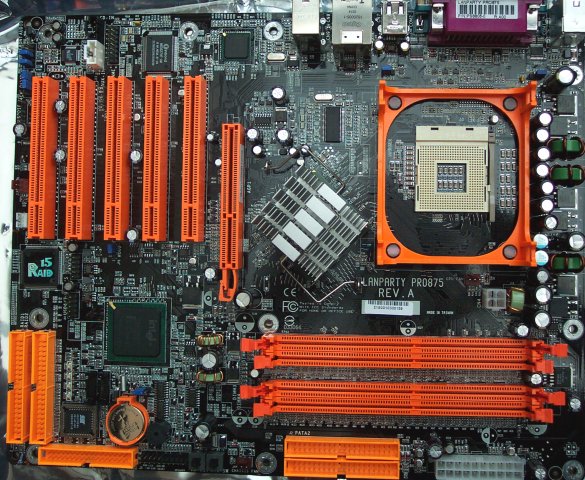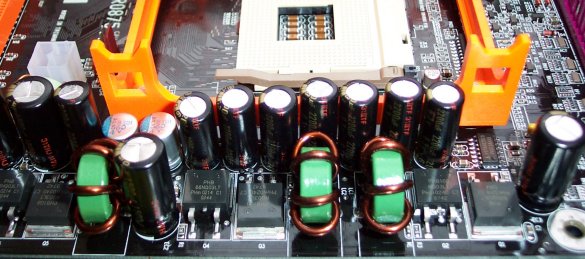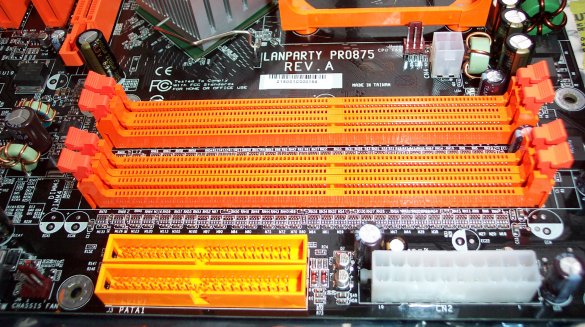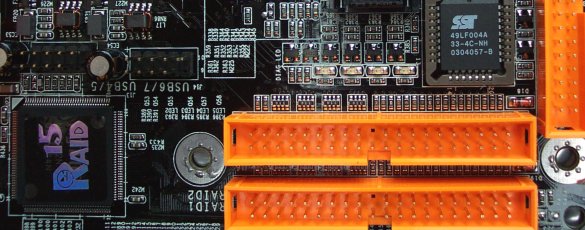Layout and Features

An eclectic mix of near-black PCB and orange slots and ports. You can plainly see that this motherboard is aimed at users with side windows to their PC cases. It's of no coincidence that the rounded cables match the orange colouring of the slots and ports, either. A number of manufacturers go for neutral colours, DFI give you the love it or hate it choice.

As is the case with every Canterwood board that we have come across, the DFI PRO875 has the CPU socket facing the DDR slots. Each and every Springdale board has had the socket's lever pointing towards the i865xx Northbridge. At least manufacturers are consistent. A 3-phase power design is littered with the usual glut of voltage-smoothing capacitors. As you can see from the very first picture, the retention bracket almost touches the oversized, passive MCH heatsink. Clipping in a cooler from that side can be a little tricky. Notice the rather odd location of the 4-pin 12v power plug, right next door to the CPU's fan header.

The absence of the usual floppy port (located further down) gives us a little more room to work with here. We like the location of the main 20-pin power connector, it's simple to get to and the trailing cables stay out of the board's way. A second fan header would not have gone amiss here. One can never have enough cooling possibilities. The signature 4 DDR slots, allowing for dual-channel DDR-400 operation through three possible combinations, can hold up to 4GB of unbuffered memory. With the low pricing of today's 512MB sticks one could easily run 2GB in a home environment. It's pleasing that DFI haven't gone down the route of many manufacturers by ensuring that there's a reasonable amount of room between the probable location of an AGP card and the DIMM slot locks. Having to remove the video card before attempting to remove system RAM is a pet peeve of ours.

A handy addition to any motherboard are these two invaluable buttons on the right-hand side of the usual motherboard-to-case connectors. Put simply, they allow you to start and reset the motherboard without having to either put the motherboard in a case or short out the requisite pins. Great for tinkering about with, especially if you're exploring the limits of your system. The second of three fan headers can be seen on the right.
The DFI PRO875 carries Intel's on-hub S-ATA controller. The ICH5/R, specified here, further allows the user to run S-ATA drives in RAID0 and, if setup correctly initially, allows the possibility of adding a second S-ATA RAID-forming drive at a later date.

A number of motherboard manufacturers have then gone on to add a PCI-based S-ATA controller and two further ports. We've mentioned the lack of IDE RAID on premium motherboard these days. It seems as if DFI understand and appreciate this slight shortcoming for the vast number of users with standard IDE drives. The two IDE RAID ports sit perpendicular to the oddly placed floppy port, all in orange, of course. The RAID controller is none other than the trusted Highpoint HPT372N that we saw specified on a number of motherboards last year. It's capable of running ATA133-compatible drives in either independent, RAID0, RAID1, and RAID0+1 formats. Given that the most popular drives are still IDE, this feature makes a great deal of sense. You can see a couple of USB2.0 headers just above the RAID controller, presumably to be attached to the FrontX panel.
Just to the left of the BIOS chip are four LEDs. Much like MSI's D-Bracket, they attempt to troubleshoot failed bootups. A certain combination of the four LEDs highlights certain problems, which can then be cross-referenced against the manual. The POST sequence goes through 15 different combinations before giving the all clear. Another handy and useful touch.


A couple of nice, expected features here. On-board sound isn't as bad as it was just a few years ago. Try listening to the CMI9739A 5.1-capable CODEC and you may well be surprised at its ability. Its usefulness extends to outputting digitally through a S/PDIF interface. DFI include handy add-on S/PDIF coaxial connections housed on a PCI plate. Intel's CSA Gigabit LAN, shown on the right, will please purists.

About the only thing we feel is missing from this board is FireWire support. A pretty standard I/O grouping here. Above average, once again. Just a personal observation here, but the board did seem to bend quite easily, even with the minimal use of force. It's a standard 4-layer PCB.









